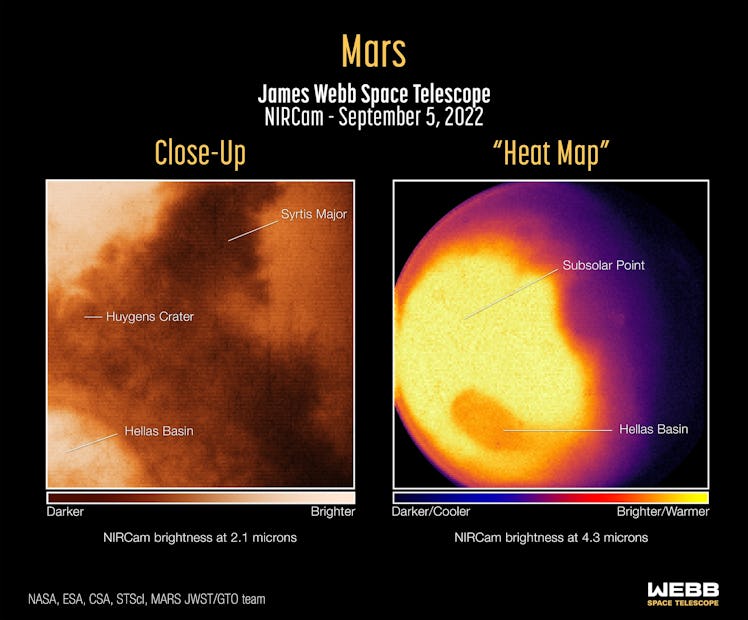JWST’s First Images Of Mars Are Unlike Any From The Red Planet
Scientists are hoping the JWST is the key to answering longstanding questions about the Red Planet.

At this point, we might as well ask ourselves what can't the James Webb Space Telescope (JWST) do because each new image release leaves us stunned. The latest drop of images gives us a look at Mars in a way we've never seen the planet before, and it's awe-inspiring.
On September 19, at the Europlanet Science Congress (EPSC) 2022, the first images and spectra of Mars from the JWST were released, according to Space.com. The JWST took these photos and measurements on September 5, showing the planet in a whole new light, both figuratively and technically.
The telescope uses infrared light, which we've not previously been able to use to view Mars. And it's revealed a lot more information about the Red Planet. It could also provide scientists with a unique view of the planet with data they've never been able to collect before.
Mars is relatively close to the JWST, the most sensitive and powerful telescope ever launched, designed to allow scientists to see further into space than we've seen before, and it's already expanded what researchers can see. However, having the JWST so close to Mars presented a tricky job for the telescope.
"Mars is so bright that the challenge is how to see it," Giuliano Liuzzi, a NASA Planetary Systems Laboratory at Goddard Space Flight Center scientist and lead investigator, said in an EPSC press conference to mark the release of the images, per Space.com. The proximity of Mars meant the telescope risked becoming overheated or rendering its instruments useless due to the brightness of the planet.
The James Webb Space Telescope's first near-infrared spectrum of Mars, captured by the Near-Infrared Spectrograph (NIRSpec) on Sept. 5, 2022. (Image credit: NASA, ESA, CSA, STScI, Mars JWST/GTO team)
Scientists tackled the issue by using very short exposures of the JWST instruments to look at Mars. This required very small measurements of light that hit the telescope's detectors and specific methods for analyzing the collected data.
And it worked. "We can see this incredible resolution; we have the diffraction limit of a space telescope in the infrared, which is fantastic. So we can see the whole planet," Liuzzi shared.
The side of the planet viewed by JWST shows two wavelengths of infrared light, both the sunlight reflecting off the surface, and the brightest part of the atmosphere where the sun is directly in line with the planet.
The telescope also observed a dark smear at the bottom of the brightest region, Space.com reports. That dark spot is called the Hellas Planitia, the largest crater on Mars — and the largest in the entire Solar System.
Scientists are hoping that with the help of the JWST's infrared capabilities they'll be able to obtain more precise details about the planet's atmosphere, specifically to end the debate on whether methane is present on Mars. Ground-based rovers have found methane on the planet, but other tools haven't been able to confirm the finding.
"The big conundrum has been that the rovers on the surface and the observational data have left a gap between zero and 10 kilometers [6 miles]," Liuzzi said. "Now we have James Webb, we can see the full column [of the atmosphere] all the way to the surface where the rover is. So we've provided a new way to solve this conundrum."